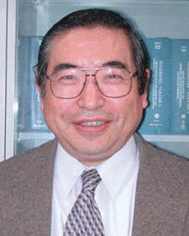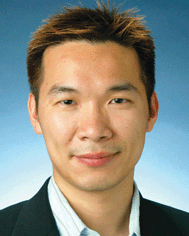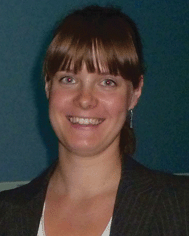Chem Soc Rev – staying radical
Abstract
To be radical typically means being unconventional, nonconformist, extraordinary. To be different from what is routine. But the word itself – from the Latin radix, meaning ‘root’ – also means staying focussed on the fundamentals. For Chem Soc Rev, 2013 has been an experience of being radical in both senses, and 2014 promises to be even more so.
Bigger and faster
Chem Soc Rev continues to be the largest publisher of general chemistry reviews, having published 432 reviews across 24 issues in 2013 – nearly double the size of our closest competitor journals (Fig. 1). Hand in hand with this continued growth, the quality of reviews has continued to rise, with this year seeing our highest-ever rejection rate. By sending out clear and specific guidelines to referees on the high standards we expect, and by defining impartial acceptance criteria for review proposals assessed by our Editorial Board members, we have effectively raised our benchmark for Chem Soc Rev. There is no doubt that our growth is therefore a result of an increase in quality submissions, generated through targeted commissioning and topical themed issues.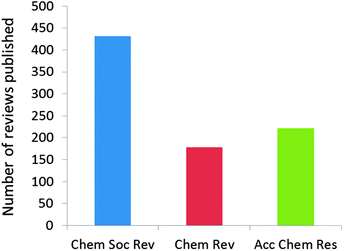 | ||
| Fig. 1 Number of reviews published in general chemistry review journals in 2013 (data for Chem Rev and Acc Chem Res collected from respective journal websites on 07 November 2013). | ||
Our journal impact factor for 2012 remains high at 24.89, with our immediacy index having risen this year from 5 to nearly 8 (Fig. 2). With these impressive figures, Chem Soc Rev remains ranked as the #2 review journal within general chemistry, as well as being second overall in the multidisciplinary chemistry journal category in the 2012 Journal Citation Reports® (Thomson Reuters, 2013).
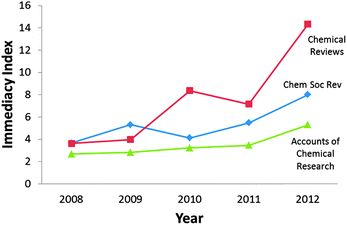 | ||
| Fig. 2 General chemistry review journal immediacy indices over the past 5 years (data from 2012 Journal Citation Reports® (Thomson Reuters, 2013)). | ||
Focus on quality
We have seen this remarkable growth and undiminished quality as a result of our commitment to publishing only the most topical and interesting reviews. The 2013 most accessed Review Articles (Table 1) and Tutorial Reviews (Table 2) give an idea of our most downloaded and popular themes: graphene/functionalised nanomaterials, photocatalysis/photovoltaics, sensors/microfluidics, and others.| Review title | Authors | DOI |
|---|---|---|
| The chemistry of graphene oxide | Daniel R. Dreyer, Sungjin Park, Christopher W. Bielawski and Rodney S. Ruoff | 10.1039/B917103G |
| Heterogeneous photocatalyst materials for water splitting | Akihiko Kudo and Yugo Miseki | 10.1039/B800489G |
| Nanomaterials for energy conversion and storage | Qifeng Zhang, Evan Uchaker, Stephanie L. Candelaria and Guozhong Cao | 10.1039/C3CS00009E |
| Graphene-based composites | Xiao Huang, Xiaoying Qi, Freddy Boey and Hua Zhang | 10.1039/C1CS15078B |
| Nanostructured metal chalcogenides: synthesis, modification, and applications in energy conversion and storage devices | Min-Rui Gao, Yun-Fei Xu, Jun Jiang and Shu-Hong Yu | 10.1039/C2CS35310E |
| Review title | Authors | DOI |
|---|---|---|
| Biosensors: sense and sensibility | Anthony P. F. Turner | 10.1039/C3CS35528D |
| Progress, challenge and perspective of heterogeneous photocatalysts | Yongquan Qu and Xiangfeng Duan | 10.1039/C2CS35355E |
| Metal dichalcogenide nanosheets: preparation, properties and applications | Xiao Huang, Zhiyuan Zeng and Hua Zhang | 10.1039/C2CS35387C |
| Carbon-based materials as supercapacitor electrodes | Li Li Zhang and X. S. Zhao | 10.1039/B813846J |
| Shape control in gold nanoparticle synthesis | Marek Grzelczak, Jorge Pérez-Juste, Paul Mulvaney and Luis M. Liz-Marzán | 10.1039/B711490G |
It is now a year on since the launch of our revamped Tutorial Reviews, and we have been delighted with the enthusiastic and positive response we have received from authors and readers alike. We continue to welcome your feedback on our Tutorials, so please do let us know what you think.
Themed issues
Part of our ongoing strategy, as a top-quality general chemistry reviews journal, is to publish topical and transformational themed issues from across the complete spectrum of the chemical sciences. These issues contain contributions from leading groups in the field and are guest edited by prominent scientists from all over the world. Table 3 shows the ten outstanding themed issues we have published in 2013, with this number expected to go up to 12 – making up half of our 24 issues – in 2014. To give you a sneak peek at what's in store for 2014, keep an eye out for our themed issue on molecular medicine and neurodegenerative diseases (guest edited by Mi Hee Lim, Christopher Chang, Benjamin Cravatt and Doug Johnson) and, in celebration of the 2013 Nobel Prize in Chemistry winners, don't miss our themed issue on applied computational chemistry (guest edited by Israel Fernández & Fernando P. Cossío) later in the year.| Title | Guest Editors | Issue |
|---|---|---|
| Alfred Werner Nobel Prize 100 year celebration | Edwin Constable & Philip Gale | 4 |
| Solar fuels | Harry Gray, Bruce Brunschwig, Jay Winkler, Siddharth Dasgupta | 6 |
| Chemistry of functional nanomaterials | Yadong Yin & Dmitri Talapin | 7 |
| Mesoporous materials | Bénédicte Lebeau, Anne Galarneau, Mika Linden | 9 |
| Carbohydrate chemistry | Injae Shin & Kwan Soo Kim | 10 |
| Multivalent scaffolds in glycosciences | Olivier Renaudet & René Roy | 11 |
| Enzyme immobilisation | Ulf Hanefeld, Linqiu Cao, Edmond Magner | 15 |
| Stimuli responsive materials | Rachel O'Reilly, Thomas Epps, III, Brent Sumerlin, Patrick Theato | 17 |
| Mechanochemistry | Stuart James & Tomislav Friščić | 18 |
| Chemical and biological detection | Frances Ligler, Timothy Swager, Charles McEwen | 22 |
Editorial Board changes
Last year, we bid farewell to Professor Dirk Guldi and welcomed Professor Philip Gale as the new Chair of the Chem Soc Rev Editorial Board. Professor Gale (University of Southampton, UK) has been on the Chem Soc Rev Editorial Board since 2005, having acted as both a Commissioning Editor and, more recently, as Associate Editor handling reviews in supramolecular chemistry.
We also welcomed Professors David Amabilino (ICMAB-CSIC, Spain) and Huw Davies (Emory University, USA) as new Associate Editors for supramolecular chemistry, and for organic chemistry and catalysis, respectively, bringing the number of our Associate Editors up to four.
Professor Shunichi Fukuzumi (Osaka University, Japan) was also a new and welcome addition to our Editorial Board this year, bringing in his expertise in physical chemistry, particularly in artificial photosynthesis and electron transfer chemistry.
We are deeply grateful to all of our Editorial and Advisory Board members for their loyalty and commitment to Chem Soc Rev, and for continuing to push the journal towards quality and excellence. In particular, we would like to thank Professor Dirk Guldi, who steered Chem Soc Rev towards its highest-ever impact factor (28.76, 2011 Journal Citation Reports® (Thomson Reuters, 2012)) during his three-year term as Editorial Board Chair.
Emerging investigator lectureship 2013
For six years running, Chem Soc Rev has proudly recognised emerging scientists who have made significant contributions to their respective research fields. Last year, Professor Xile Hu from the École Polytechnique Fédérale de Lausanne (EPFL) in Switzerland beat off tough competition and was chosen by our Editorial Board as the winner of the 2013 Chem Soc Rev Emerging Investigator Lectureship. Professor Hu was selected in recognition of his work in the field of catalysis, particularly his development of catalysts composed of earth-abundant elements used in sustainable chemical synthesis and for efficient chemical energy storage. He will be presenting his award lecture in summer 2014 at the EUCHEM Conference on Organic Free Radicals in Prague, Czech Republic.
This year, we continue to recognise excellence and achievement in the chemical sciences with our Emerging Investigator Lectureship Award for 2014 – nominations accepted until December 2013 and the winner to be announced soon.
Journal altmetrics
We are always on the look-out for innovative ways of measuring the impact of our articles – Chem Soc Rev is proud to be one of the first five Royal Society of Chemistry journals to experiment with Journal Altmetrics, which allows you, our authors, to check the social impact and relevance of your articles. Read more about our new online metrics feature at http://www.rsc.org/AboutUs/News/PressReleases/2013/Altmetric-partnership-article-level-metrics.asp.Our new look – in full colour
In case you haven't noticed, we have launched a colourful, modern design for our logo and cover layouts. We have ambitious goals and, to reach them, we want to build a greater awareness of Chem Soc Rev and the Royal Society of Chemistry. We feel our new logo reflects the dynamic creativity of chemistry – it's about collaboration and community, becoming stronger as it builds and overlaps. We have also made some changes to the way our articles look to reflect our new brand, make an impact and, most importantly, make it easier for you to read and navigate. As a result, all of our articles will now be published in full colour, completely free of charge. What do you think? We'd love to hear your feedback, so please share your thoughts with us (E-mail: brand@rsc.org).Stay in touch, share your thoughts
You can count on us to always strive to outdo ourselves to give you – our authors, referees and readers – the best, truly ground-breaking, and most relevant and timely general chemistry reviews that you desire and deserve. This is why we are always so pleased to hear from you, because you give us our best ideas for improving Chem Soc Rev and pushing our quality and impact even higher. Whether you tweet us (@ChemSocRev) or email us (E-mail: chemsocrev-rsc@rsc.org; ), what matters is that you share your ideas with us. Follow us on Twitter (https://twitter.com/ChemSocRev), and drop in on our blog (http://blogs.rsc.org/cs) to stay updated on HOT reviews and most accessed articles, read posts by our talented guest writers, and hear about our latest journal news and announcements.A new year of continued excellence
Despite our fresh and dynamic appearance, we remain consistent in our vision. We will continue to focus on what really matters: quality, growth, and scientific integrity.With so much momentum driving us, the future is truly looking bright for Chem Soc Rev, and we have you – our Editorial and Advisory Board members, our authors, referees, guest editors, and readers from all over the world – to thank for the journal's continued success and achievements. We hope you agree that, by staying focussed on the basics and radical in our outlook, Chem Soc Rev is poised to accomplish even greater things this coming year. We can hardly wait.
With all our best wishes for a fruitful and successful 2014,
| This journal is © The Royal Society of Chemistry 2014 |




